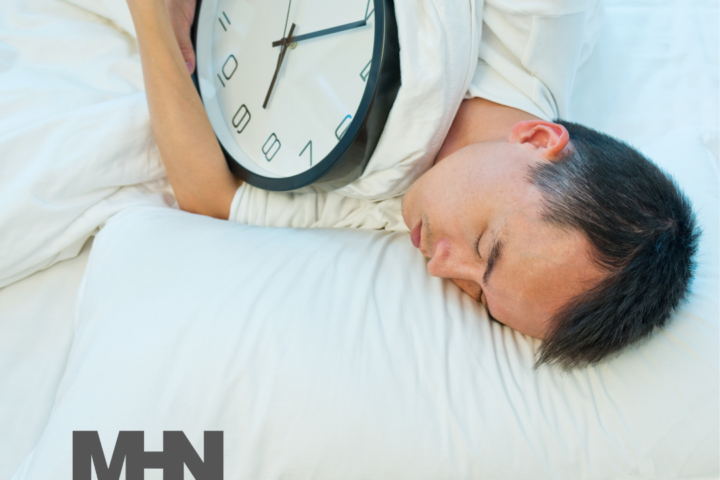Concerned about his lack of interest or other changes in his performance? It may be time to encourage him to see a doctor.
The intimate moments you share with the man in your life are important to your bond—and potentially his health. That’s because, depending on how observant he is about his body, you may be the first to detect changes in his manliness and how it’s functioning.
If his sex drive has declined—or you notice he’s using the bathroom more frequently, is gaining weight or has other changes to his physique such as breast enlargement—he may have undiagnosed health issues. A number of common sexual and reproductive health conditions can develop at any age.
Talk with your guy about what you’re noticing, and encourage him to see a health care provider for an examination.
Statistics show American men are less likely than women to see a doctor for regular checkups. Since women make 80 percent of all health care decisions, your influence really does matter. It could take some urging (note: it’s not nagging) to get that appointment scheduled, but this may be exactly what he needs you to do for him—and his health.
It’s important to let men know there are effective treatments available for sexual and reproductive problems, such as prostate issues, erectile dysfunction, male infertility, a curved penis or testosterone deficiency.
“Men are fix-it people,” says Stanton Honig, MD, director of the Male Sexual Medicine and Male Reproductive Health programs at Yale Medicine. “Men need to know if they go to the doctor, they could be cured.”
Read on for more information on symptoms that should prompt him to see a urologist:
Changes in Urinary Frequency or Volume
You may notice he wakes up to use the bathroom more frequently. His urine stream may be less powerful, and it may take him longer than usual to empty his bladder. He might stop more often to use the restroom on road trips. In addition, you might notice he is producing less semen. Maybe you’ve seen blood in his urine, and he may report finding ejaculation painful sometimes.
“All of these observations can be important warning signs of prostate issues, which may become more common as men age. Prostate enlargement is observed in many men over time and can be effectively treated by a variety of approaches,” says Michael Leapman, MD, a Yale Medicine urologist who practices at Yale Cancer Center at Smilow Cancer Hospital.
There are two kinds of prostate issues that men with these symptoms should be checked for:
Enlarged prostate: An enlarged or swollen prostate, also called benign prostatic hyperplasia (BPH), is a very common condition in men. It affects half of men by age 50 and 90 percent of men by age 80. The prostate is involved in both urinary and sexual function in men, and while not life threatening, BPH can significantly impact a man’s quality of life. In addition to causing both sexual and bathroom issues, the problem can occasionally be uncomfortable for guys who have it, especially when seated because of the prostate’s location (below the bladder).
“Both BPH and erectile issues are more common as men age,” says Yale Medicine urologist Thomas Buckley, MD. Although the exact nature of the relationship is unclear, recent studies show that men with BPH symptoms have a higher incidence of erectile dysfunction (ED). “Many of the treatments for BPH can have an impact on sexual function and satisfaction,” says Dr. Buckley. “So, it is crucial to discuss sexual function with your urologist before undertaking any treatment for BPH.”
Prostate cancer: Prostate cancer affects 1 in 7 men. To detect prostate cancer, a man’s prostate-specific antigen (PSA) is measured through blood tests. PSA is a protein produced exclusively by prostate cells. “The American Urological Association suggests that men ages 55 to 69 consider prostate cancer screening via a PSA blood test, based on their individual values and preferences,” says Dr. Leapman. (It’s a good discussion for a man to have with his doctor.) Also, men at increased risk—who have prostate cancer in their families or who are African American—should have this talk with their doctor sooner, between ages 40 and 54.
What can be done: For symptoms from an enlarged prostate, there are many different treatments available. The newest BPH treatment available is called UroLift, according to Daniel Kellner, MD, a Yale Medicine urologist who performs this procedure. The minimally invasive treatment is done in the doctor’s office on an outpatient basis. It solves the problem of a blocked urethra by inserting a tiny implant that pushes the enlarged prostate out of the way. No prostate tissue is removed, and the procedure takes about an hour.
Other BPH treatments your doctor may consider include:
- Medications
- Surgery
- Prostate embolization
- GreenLight Laser
Click here for more information on the above BPH treatments. Because enlarged prostate affects men to varying degrees, a urologist can help men weigh the pros and cons of each treatment and select the right one.
For some prostate cancers that are slow-growing, doctors may recommend not treating initially because the cancer is often not life-threatening. When treatments are needed, they include surgery, radiation or androgen deprivation therapy. Side effects of treatment can include urinary incontinence and impotence, which is why doctors often take a “wait and watch” approach when a man is diagnosed with prostate cancer and delay treatment until it’s warranted. Almost all prostate cancer is curable if identified early on.
Loss of Libido
If he’s suddenly or progressively unable to get or keep an erection long enough for sex, it can be concerning for both of you. While you might worry his lack of excitement means your relationship is on the rocks, there could be another explanation: a health condition called erectile dysfunction (ED).
It’s estimated that 50 percent of men ages 40 to 70 have this problem. Its prevalence increases with age, but young men can experience it, too. ED means a man is unable to achieve or sustain an erection firm enough for sex more than half of the time. It’s normal for a man to have a problem now and again. But he’s probably feeling embarrassment and stress about it.
“If a man fails once in the bedroom, it can happen again and may become a self-fulfilling prophecy,” says Dr. Kellner. “Because of fear of failure in the bedroom, men may even avoid sexual activity.”
What men shouldn’t avoid is talking about the problem with a doctor, because it could be a symptom of some serious health concerns, including heart issues. “Some cardiac diseases affect the ability to have erections,” Dr. Kellner says.
Other conditions that commonly go hand-in-hand with ED include:
- Kidney disease
- Diabetes
- High cholesterol
- Nerve injuries
- Obesity
- Lack of physical fitness
- Smoking
- High blood pressure
What can be done: First things first: talk to him about it. Chances are he’s feeling uneasy about not being able to perform—or not being the strong performer he once was. The pressure he’s likely putting on himself to do better next time isn’t going to help him psychologically or sexually.
If erectile issues are happening frequently, have him see a urologist (who is like a gynecologist for men). Urologists specialize in issues related to the penis, testicles and prostate.
ED issues can motivate a reluctant man to see a doctor for a checkup. It’s an opportunity to address not only the sexual issues, but also any underlying health problems he might have as well.
Medications like Viagra and Cialis can help improve male performance. Other solutions include local treatments to the penis such as tiny injections, penile pumps or a vacuum device that increases blood flow to the penis. Testosterone therapy can be prescribed for men with low testosterone caused by an androgen deficiency but this is more for sexual interest than hardness.
If the doctor determines that there are psychological rather than health-related roots to his erectile issues, such as depression, stress or anxiety, antidepressants or anti-anxiety medications can be helpful. If there are relationship problems, consider counseling.
Trouble Conceiving
If you and your partner have been trying for nine to 12 months to conceive with no success, it’s time to consider infertility testing for both of you. Start with him, though, suggests Dr. Honig, because unlike for women, a semen analysis is noninvasive.
He’ll need to collect a semen sample at home and deliver it to the urologist’s office within one hour for analysis. Encourage him to have a sperm check sooner if you’ve been trying for six months and you’re approaching 35, or if something in his medical history suggests he could have male-factor fertility issues such as:
- An undescended testicle
- Enlarged veins (called varicocele)
- An injury to the testicle
- Testicular cancer
- Previous cancer treatment with chemotherapy or radiation.
All of these factors can affect a man’s sperm count and quality.
What can be done: If a male fertility issue is detected (50 percent of the time it’s related to the man), a reproductive urologist is the right doctor to see. This specialist can look for penile and testicular causes of sperm problems, as well as consider other health issues that may be involved.
“Male fertility problems can be a harbinger of other health issues such as prostate or testicular cancer, genetic issues or underlying physical problems,” says Dr. Honig. That’s why it’s important to have him evaluated and not just skip ahead to artificial insemination or in vitro fertilization. Often when the health problems are addressed, the male fertility issues get solved as well.
If you and your partner, however, have decided against having children and have found you don’t need to use protection, still have him consult a doctor to make sure your guy doesn’t have any underlying health issues. It’s a good chance to get more information about vasectomies, if desired. They’re a permanent and reliable form of birth control for couples. “And it’s much easier for a man to have a vasectomy than for a woman to have her tubes tied,” says Dr. Honig. Vasectomies take about 15 minutes and require 48 hours of downtime, with little discomfort, for most men.
A Bend or Curve
If you notice his penis seems bent, it really might be. A common but little-known condition, called Peyronie’s disease, affects 1 in 11 men. It happens when the penis “breaks.” It usually occurs during penetration, when a man accidentally bumps his partner’s pubic bone. Peyronie’s disease can also result from a sports injury.
“Eighty percent of men don’t even remember a specific time they had the injury,” says Dr. Honig. Typically, what they notice is, a couple of weeks afterward, erections start to hurt. Scar tissue called plaque begins to build, causing the penis to bend. He may develop erectile dysfunction, and the curvature can make sex difficult or even impossible.
What can be done: An FDA-approved medication called collagenase, prescribed under the brand name Xiaflex, can help by breaking down the scar tissue. When Peyronie’s disease is more severe, it is very fixable—microsurgery can straighten the curvature.
Weight Gain all Over
Just like women, men can experience hormonal changes as they approach their early 40s. So if he’s nearing midlife, it’s worth noting if he’s uninterested in sex, has gained weight, isn’t sleeping well and is moody. He might also have breast development, sometimes called “man boobs,” which is medical condition called gynecomastia.
“He may also experience erectile dysfunction, fatigue, muscle weakness and loss of body hair, which can be signs of hormone imbalance in men,” says Silvio Inzucchi, MD, a Yale Medicine endocrinologist. “Sometimes the condition is due to dysfunction of the testicles or the pituitary gland, the latter of which regulates testicular function.”
Approximately 4 out of 10 men over 45 have a hormonal androgen deficiency called low testosterone or low T (hypogonadism), reports the Urology Care Foundation. In addition to causing all of the above symptoms, it can also make him feel frustrated both at work and at home.
What can be done: Leaner men who have body mass indexes in the normal range are less likely to experience low T. So are men who keep their alcohol consumption within the daily recommended limits (up to two drinks a day, according the National Institute on Alcohol Abuse and Alcoholism). A healthy lifestyle helps avoid low T. Eating better and exercising can improve matters for men diagnosed with the condition; many also have other health challenges, such as obesity or diabetes, which lifestyle changes can help.
A simple test of early-morning testosterone levels will usually help make this diagnosis, says Dr. Inzucchi. A urologist, endocrinologist or primary care doctor can test a man for testosterone deficiency. If diagnosed with low T, his doctor will likely discuss prescription testosterone therapy. (Dissuade him from using over-the-counter testosterone supplements, though, which are not proven and could be harmful, says Dr. Honig.)
Another caution: If your vision for the future includes children, he should avoid taking testosterone. It can affect sperm count and quality—sometimes permanently.
Testosterone therapy is considered safe and effective when properly prescribed by a doctor who has ruled out other causes of low T, such as pituitary gland problems or sleep apnea.
Properly prescribed hormone therapy can help a man build muscle mass and feel like himself again, reinvigorating his sex drive and evening out moodiness. “With treatment, wives are so grateful,” says Dr. Honig. “They often tell me, ‘Thank you for giving me my husband back again.’”
To learn more about the Yale Medicine Urology’s Male Sexual Medicine Program, click here.
This article originally appeared, in a slightly different format, on the YaleMedicine website.




